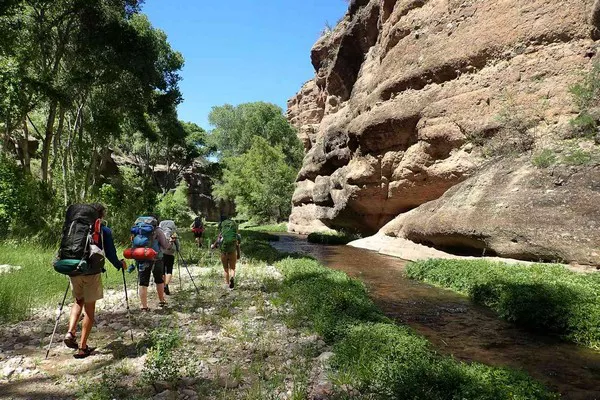As the vibrant hues of spring blanket the landscape, May presents an ideal window for outdoor enthusiasts to lace up their boots and hit the trails. With longer daylight hours and milder temperatures, this transitional month beckons adventurers to explore the great outdoors. From towering peaks to tranquil woodlands, there’s a plethora of hiking destinations waiting to be discovered. Whether you’re seeking a challenging summit ascent or a leisurely stroll amidst blooming wildflowers, May offers an array of options to satisfy every hiker’s craving for adventure.
Trail Descriptions
1. Mount Marcy, Adirondack High Peaks, New York
- Difficulty Level: Strenuous
- Distance: Approximately 14 miles round trip
- Elevation Gain: 3,166 feet
- Estimated Hiking Time: 8-10 hours
- Scenery: Spectacular panoramic views of the Adirondack Mountains, dense forests, alpine vegetation.
- Points of Interest: Summit of Mount Marcy, the highest peak in New York State, Lake Tear of the Clouds, the source of the Hudson River.
2. Angel’s Landing, Zion National Park, Utah
- Difficulty Level: Strenuous
- Distance: 5.4 miles round trip
- Elevation Gain: 1,488 feet
- Estimated Hiking Time: 4-5 hours
- Scenery: Jaw-dropping vistas of Zion Canyon, towering sandstone cliffs, lush vegetation.
- Points of Interest: Angel’s Landing summit, Walter’s Wiggles, breathtaking views of the Virgin River.
3. The Narrows, Zion National Park, Utah
- Difficulty Level: Moderate to Strenuous
- Distance: Variable (up to 16 miles round trip)
- Elevation Gain: Minimal
- Estimated Hiking Time: 6-10 hours (depending on route)
- Scenery: Winding slot canyons, towering walls of red rock, shimmering Virgin River.
- Points of Interest: Wall Street, Orderville Canyon, lush hanging gardens.
Weather Conditions in May
May typically brings pleasant weather conditions for hiking in many regions, but it’s essential to be prepared for variable conditions, especially in mountainous areas.
1. Average Temperature: Temperatures can vary widely depending on location, ranging from mild to warm. In mountainous regions, temperatures may still be cool, especially at higher elevations.
2. Rainfall: May is often characterized by moderate rainfall in some regions, so it’s advisable to pack waterproof gear and be prepared for sudden showers.
3. Potential Challenges: While lower elevations may be snow-free, higher elevations, particularly in mountainous areas, may still have lingering snowpack. Hikers should be cautious of slippery or icy conditions, especially on shaded north-facing slopes.
Accessibility
Before embarking on any hiking adventure, it’s essential to plan ahead and ensure you have the necessary information for accessing trailheads:
1. Trailhead Location: Research the precise location of the trailhead and plan your route accordingly. GPS coordinates or detailed directions can be invaluable.
2. Parking Information: Some trailheads may have limited parking, especially during peak times. Arrive early to secure a spot or consider carpooling.
3. Permits or Fees: Certain hiking areas may require permits or have entrance fees. Check ahead of time and obtain any necessary permits to avoid any issues.
Nearby Attractions and Amenities
Exploring the great outdoors often goes hand in hand with enjoying nearby attractions and amenities:
1. Camping Options: Many hiking destinations offer nearby campgrounds or backcountry camping opportunities. Check for availability and any reservation requirements.
2. Lodging: For those seeking more comfortable accommodations, nearby hotels or lodges can provide a restful night’s sleep after a day on the trails.
3. Restaurants: Refuel after your hike with a hearty meal at local restaurants or cafes, sampling regional cuisine and flavors.
4. Other Outdoor Activities: Extend your outdoor adventure by exploring additional recreational activities in the area, such as rock climbing, mountain biking, or wildlife watching.
Safety Tips and Recommendations
While hiking in May can be an exhilarating experience, it’s crucial to prioritize safety and preparedness:
1. Gear Suggestions: Wear sturdy hiking boots with good traction, dress in layers to accommodate changing weather conditions, and pack essentials such as water, snacks, a map, compass or GPS device, first aid kit, and emergency shelter.
2. Leave No Trace Principles: Practice responsible outdoor ethics by minimizing your impact on the environment. Pack out all trash, stay on designated trails, and respect wildlife and vegetation.
3. Wildlife Awareness: Be mindful of wildlife encounters, particularly in areas with bears or other potentially dangerous animals. Carry bear spray if hiking in bear country and know how to use it.
4. Hydration: Stay hydrated throughout your hike by drinking water regularly, especially in warmer temperatures. Consider carrying a water filtration system for refilling water bottles from natural sources.
5. Hiking Buddies: Whenever possible, hike with a companion or in a group, especially on more remote or challenging trails. Share your itinerary with someone trusted and check in periodically.
Conclusion
In conclusion, May offers a wealth of opportunities for hiking enthusiasts to immerse themselves in the beauty of the natural world. Whether you’re drawn to rugged mountain peaks, tranquil forest trails, or winding canyon pathways, there’s a hiking adventure awaiting you. By heeding weather forecasts, preparing adequately, and respecting the environment, you can make the most of your hiking experiences in May while staying safe and enjoying all that nature has to offer.

